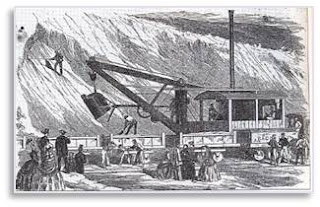Now
that I have finished my Boston by Foot docent training and passed the final
(both written and verbal), it’s time to learn the tour that I have chosen to
give. Many different tours are offered
by @bostonbyfoot and there’s so much to know that learning to do one well
before branching out is the wisest course.
I chose the Victorian
Back Bay tour for several reasons.
The filling of the Back Bay is an engineering marvel that I find fascinating
along with the resulting construction requirements for all of the
nineteenth-century houses and many of the twentieth-century buildings.
When
the Puritans landed in 1630, Boston looked very different than it does
now. At that time, the Shawmut peninsula
was made up of three irregularly shaped lobes at the end of a long, narrow
neck. All together, there were no more
than 487 acres of habitable land on the peninsula and a fair amount of that was
taken up by hills. There was the TriMountain—Beacon
Hill, Pemberton Hill, and Mount Vernon—as well as Copp’s Hill and Fort
Hill.
Common wisdom blames
cow paths for Boston’s random street pattern but the poor cows have been
maligned. The first streets were laid
out by people who needed to go past the hills and around the three lobes while
on their way to important destinations like the harbor, the spring, the
pasture, the Town House, and the market. As land was filled in different
locations and at different times, more streets were created to fit the newly
created section. Nome of them fit into a
logical grid.
 |
| View of the Back Bay from the State House on Beacon Hill |
These
487 acres met the town’s needs pretty well, although land making started early
along the waterfront. Fully one sixth of
Boston is built on made land. But things
changed in the nineteenth century when a variety of influences drove a need for
more land. Over that same period, the
Back Bay had been converted by damming and railroad causeways from shallow salt
marshes and mud flats on the tidal Charles River to a stagnant stinking
sewer. Everything went into it from
garbage and raw sewage to dead animals.
The tony families in their Beacon Hill homes found that Old
Mother West Wind had very bad breath.
Something had to be done. Something was done. A typical American combination of public need
and private enterprise resulted in the Tripartite Indenture, a settlement
reached by the City of Boston, the Commonwealth of Massachusetts and the Boston
Water Power Company. Signed on December
11, 1856, it enabled the filling of the Back Bay to begin.
 |
| Stationary Steam Shovel Filling Rail Cars |
Common wisdom says that the Back
Bay was filled in with the top of Beacon Hill but that’s not really the
case. The TriMountain, including Beacon
Hill, was indeed lowered by 60 feet and used as fill in other places but the Back
Bay’s New Land was created over 37 years with gravel from Needham, nine miles
away.
The project would not have gone
far, however, without the fortuitous invention of the steam shovel. These stationary devices loaded up to 35 rail
cars—drawn by equally new steam locomotives—in just five minutes and the trains
rolled in to a tipping point in the marsh 24 hours a day, 7 days a week. The filling proceeded from the Public Garden
on the east to the Fenway area and created much more land than is currently
included in what is now called the Back Bay neighborhood. When it was done, Boston had grown by 570
acres.
For those who are interested,
the definitive book on the land making in Boston is Gaining
Ground by Nancy Seasholes, an historian and historical archaeologist. The book
is organized geographically and each chapter deals with a specific section
of Boston. It’s big, very detailed, packed
with information, and illustrated with lots of maps and photographs.
That would be a major project today
and even now we recognize it as an engineering marvel and an enormous
technological feat. Because the New Land
was flat and relatively straight, it had a logical pattern of boulevards and
cross streets. The streets are named
alphabetically, starting at the Public Garden: Arlington, Berkeley, Clarendon,
Dartmouth, Exeter, Fairfield, Gloucester, and Hereford.
Next came building on
the New Land, which was planned as a neighborhood of elegant homes for wealthy
Yankees. Unfortunately, the real estate
consisted of uncompacted gravel and that’s not a stable base for anything
bigger than a shed. How did they do
it? More later.


No comments:
Post a Comment